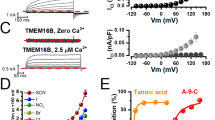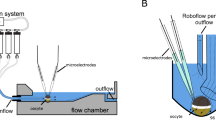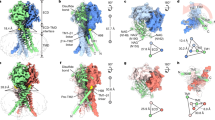Abstract
EXPOSURE of a cell to increased CO2 levels causes a drop in the intracellular pH (pHi) (ref. 1). The time development of this acidification has been monitored in snail giant neurones2 and squid giant axons3 by means of glass microelectrodes. It was found that pHi does not simply fall to a new steady value during CO2 exposure, but, given sufficient time, will slowly recover; and that, on return to a CO2-free solution, a higher pHi value (more alkaline) than the initial one is attained. The slow, secondary alkalinisation observed during exposure to CO2 cannot be accounted for by any passive mechanism, since the electrochemical gradients for H+, OH− and HCO3− all favour further acidification. For example, during the alkalinisation, the external pH (pHo) in squid axons is typically 7.7 and pHi 7.0; hence, the Nernst potentials for H+ (EH), OH−, and HCO3− are all ∼ −40 mV, compared with a membrane potential (Km) of −60 mV. Thus, a proton extruding pump, or its equivalent, must be postulated. We now report that the rate of alkalinisation is at least partially dependent on the CO2 and/or HCO3− content of the bathing medium, that it is reversibly blocked by metabolic inhibitors and that an extracellular acidification accompanies the intracellular alkalinisation.
This is a preview of subscription content, access via your institution
Access options
Subscribe to this journal
Receive 51 print issues and online access
$199.00 per year
only $3.90 per issue
Buy this article
- Purchase on Springer Link
- Instant access to full article PDF
Prices may be subject to local taxes which are calculated during checkout
Similar content being viewed by others
References
Jacobs, M. H., Am. J. Physiol., 53, 457–463 (1920).
Thomas, R. C., J. Physiol. Lond., 238, 159–180 (1974).
Boron, W. F., and De Weer, P., J. gen. Physiol. (in the press).
Hinke, J. A. M., in Glass Electrodes for Hydrogen and other Cations (edit. by Eisenman, G.), 464–477 (Dekker, New York, 1967).
Thomas, R. C., J. Physiol. Lond. (in the press).
Author information
Authors and Affiliations
Rights and permissions
About this article
Cite this article
BORON, W., DE WEER, P. Active proton transport stimulated by CO2/HCO3−, blocked by cyanide. Nature 259, 240–241 (1976). https://doi.org/10.1038/259240a0
Received:
Accepted:
Issue Date:
DOI: https://doi.org/10.1038/259240a0
This article is cited by
-
Comparison between drug-induced and K+-induced changes in molar acid extrusion fluxes (JH +) and in energy consumption rates in astrocytes
Neurochemical Research (2013)
-
Concentration-Dependent Effects on Intracellular and Surface pH of Exposing Xenopus oocytes to Solutions Containing NH3/NH4 +
Journal of Membrane Biology (2009)
-
ATP Dependence of Na+-Driven Cl–HCO3 Exchange in Squid Axons
Journal of Membrane Biology (2008)
-
Unusual permeability properties of gastric gland cells
Nature (1994)
-
Volume and pH regulation in agnathan erythrocytes: comparisons between the hagfish, Myxine glutinosa, and the lampreys, Petromyzon marinus and Lampetra fluviatilis
Journal of Comparative Physiology B (1993)
Comments
By submitting a comment you agree to abide by our Terms and Community Guidelines. If you find something abusive or that does not comply with our terms or guidelines please flag it as inappropriate.



